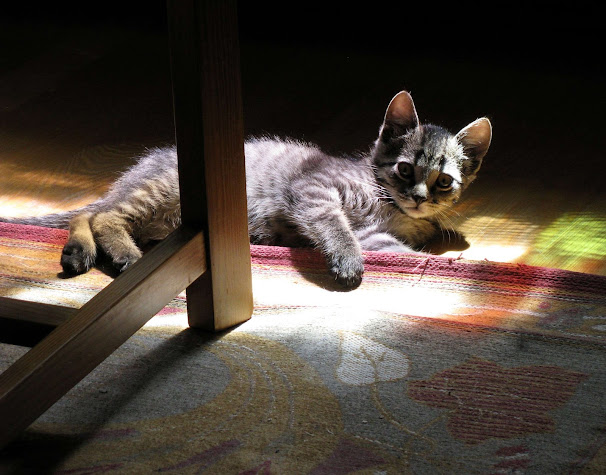You
may have heard the word "glimmer" before. Glimmers in psychology are
the opposite of triggers, small moments of peace or joy sparking
positive feelings. Those can be completely simple things that you might
not even notice consciously, but noticing and appreciating them can help
your mental health.
This week was my birthday.
You may remember my post the other day in which I vented about the piece I had wanted to make for myself as a special gift (saying it was a gift was my motivation to finally get on it) which went completely wrong. While having a very vague idea how I could not save the piece the way I imagined it, but try a different approach, that obviously didn't work out in time.
Then a surprise parcel arrived a few days early. I was completely clueless when I opened it, I had never heard of the shop and wondered what was going on.
The parcel contained a cat figurine, but no card, no nothing.
Could this be a mistake? No because the next day I got an email.
I met M. on Plurk (a social networking and microblogging service) many years ago. We live in different countries and have never met in person, but we never lost contact which I'm very happy about.
The email's title was "A feline spirit to celebrate 60" and I'd like to share these lines with you because I think they are absolutely wonderful:
"There are prettier cats, funnier ones, those with more history, and probably ones that better suit your style or your home. But what I like about this one is that it's precisely an anonymous cat - not representing a specific one but capable of representing them all: past cats, present cats, and future ones. It's like a spirit, a totem of cats, saying: "this home makes cats happy.""
Isn't that perfect?
And please ignore the voice from the background saying he would be even happier if he got more snacks.
On the birthday itself, I put the recycling bag into the hallway to take it down later and found a pretty box with a gift from my neighbors. What a nice surprise at 5 in the morning!
For that day, I expected a cat food parcel and thanks to an email from the postal service obviously also one from the drugstore which puzzled me as I hadn't ordered anything from there.
Quite early in the morning the bell rang which completely confused me because it was way too early for the mailman ... and had she said "flowers" through the intercom?
Flowers indeed, sent a by a good friend! Look at that!
The next surprise came in form of my sister who brought me something from the oldest café in town. I didn't think of taking a picture there, sorry. All I could think "my precioussss" and eat the cake.
When the announced parcels arrived, I knew again what the drugstore parcel had been about. At least three months ago, I had checked a box for the giveaway of a test box with four products while I was on the drugstore website. I had completely forgotten about it as I never win anything, anyway!
What a coincidence that it arrived that day.
Also this week a print arrived that I ordered because it's perfect for me, but I will show you that one in another post.
Now you may say, well, it was your birthday, you must have expected something.
I didn't really. My birthday is not a big thing to me, no celebration, no party, so it was really not just the gifts themselves although I loved them of course, but the surprises that made it extra special and knowing someone thought of me (well, not the drugstore of course).
And who knows, maybe I will be able to finish that gift to myself after all. Wish me luck!


















































